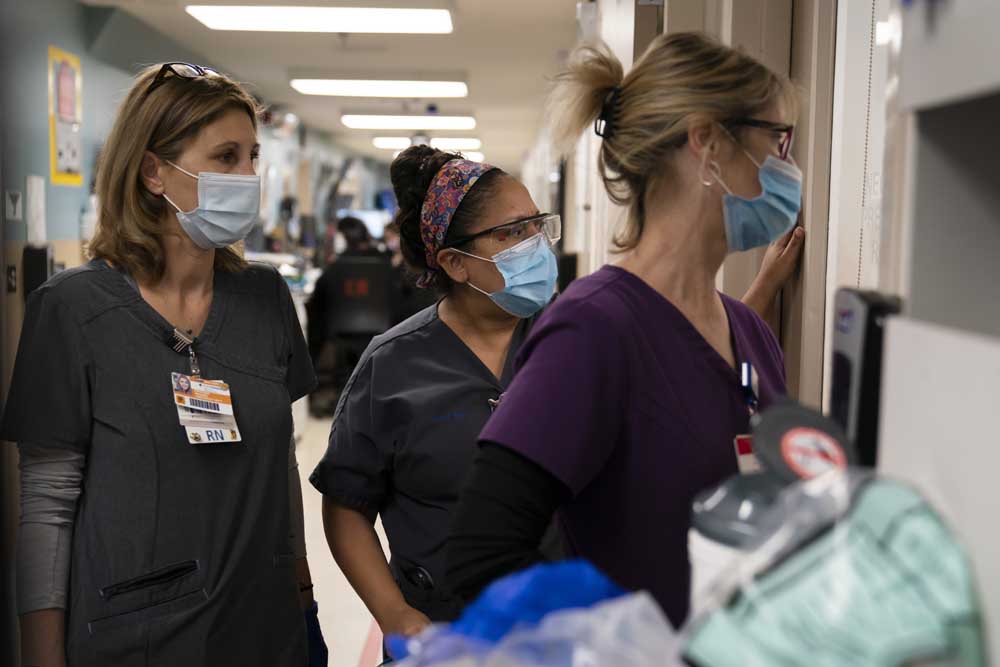CDC: New isolation and quarantine guidelines for healthcare workers to prepare for anticipated increase in omicron cases
Published 5:45 am Monday, December 27, 2021

- Registered Nurse Kristina Shannon, from left, chaplain Andrea Cammarota, and Emergency Room charge nurse Cathy Carter watch as medical workers try to resuscitate a patient who tested positive for coronavirus Thursday in the emergency room at Providence Holy Cross Medical Center in the Mission Hills section of Los Angeles. The surge of coronavirus is taking an increasingly grim toll across the United States, even as of a vaccine appears close at hand.
The Centers for Disease Control & Prevention on Thursday announced changes to isolation and quarantine guidelines for healthcare workers in an attempt to ultimately prepare hospitals for the anticipated increase in omicron cases.
The update decreases the time a healthcare worker is required to isolate after infection with COVID-19 from previously being 14 days to now seven days.
Trending
Thursday’s updates apply only to the healthcare workforce with the intention of providing healthcare facilities with strategies to limit the effects of staff shortages caused by COVID-19 on patient care. As additional information on the Omicron variant becomes available, the guidelines may be revised, the CDC said.
With local hospitals already experiencing staffing shortages and implementing incentives to keep their staff there, a new wave of omicron cases across the United States is soaring and health experts say it’s only a matter of time before it arrives in East Texas.
The CDC implemented that healthcare workers with COVID-19 who are asymptomatic can return to work after seven days if they have a negative test result. They also added isolation time can be cut shorter if there are staffing shortages.
In addition, the CDC announced healthcare workers who have received all COVID-19 vaccine doses and the booster do not need to quarantine at home following a high-risk exposure.
“CDC continues to evaluate isolation and quarantine recommendations for the broader population as we learn about the Omicron variant and will update the public as appropriate. CDC strongly encourages COVID-19 vaccination for everyone 5 and older and boosters for everyone 16 and older – vaccination is the best way to protect yourself and our healthcare system from the impact of COVID-19,” the CDC wrote.
Although the omicron variant has yet to be detected in East Texas, the community should assume the virus is already here, a health official said earlier this week.
Trending
When it comes to confirming a variant, testing technology, such as polymerase chain reaction (PCR) tests and rapid tests, Cummins said, is still accurate in diagnosing COVID. Locally, a positive result would confirm COVID-19 but not necessarily which variant, as hospitals have to rely on the state for that determination. Rather than testing every specimen for the omicron variant’s specific genomic sequencing, the state selects random positive tests to test for the variant, possibly explaining why the area hasn’t seen a confirmed omicron case reported yet.
In other areas of the country, major entertainment and sporting events are seeing cancellations, and hospitals in the U.S. are starting to become overwhelmed. Some states have also imposed indoor mask mandates.
The variant has caused a COVID-19 surge again as it sweeps the nation, and slowly, local COVID cases are seeing an increase in Smith County, Gregg County and surrounding rural counties.
UT Health East Texas’ Chief Medical Officer Dr. Tom Cummins said in an interview earlier this week a sharp, sudden rise in positive cases will be the first clue the omicron variant is present within the community.
“We’re only seeing a little bit of a bump, but not on the level that we’ve seen in other parts of the country,” Cummins said.
As a potential surge approaches East Texas, Cummins encouraged vaccines and masking in public, especially in crowded areas. He added that data shows those who have had three doses of either the Pfizer or Moderna vaccine have higher antibody resistance, even to the new mutated variant, and decreases the likelihood of severe infection, hospitalization or death.
“As the healthcare community prepares for an anticipated surge in patients due to Omicron, CDC is updating our recommendations to reflect what we know about infection and exposure in the context of vaccination and booster doses. Our goal is to keep healthcare personnel and patients safe, and to address and prevent undue burden on our healthcare facilities. Our priority remains prevention — and I strongly encourage all healthcare personnel to get vaccinated and boosted,” CDC Director Dr. Rochelle Walensky said.
In data published Thursday by the CDC, the U.S. logged a seven-day COVID case rate of 371.3 per 100,000 people in the country. The seven-day percent positivity is 9.58% and the level of community transmission in the U.S. is “high,” the highest level of community transmission possible.





